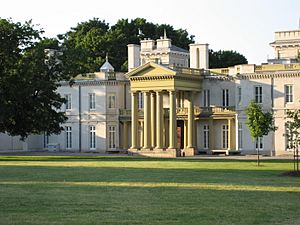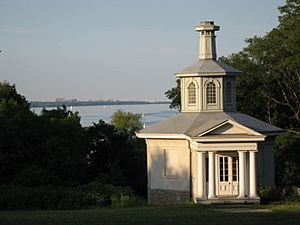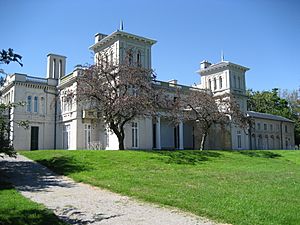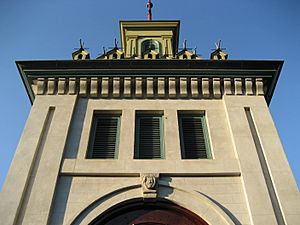Dundurn Castle facts for kids
 |
|
| Established | 1830s |
|---|---|
| Location | 610 York Boulevard Hamilton, Ontario, Canada |
| Type | Regency château |
| Designated: | 1984 |
Dundurn Castle is a beautiful old mansion in Hamilton, Ontario, Canada. It looks like a grand château and was built in a style called neoclassical. This huge house is about 1,672 square meters (18,000 square feet) in size. It took three years to build and was finished in 1835.
The house has forty rooms and was very modern for its time. It even had gas lighting and running water! Today, the City of Hamilton owns Dundurn Castle. They bought it around 1899 or 1900 for $50,000. The city has spent almost $3 million to fix it up so people can visit. The rooms have been carefully restored to look just like they did in 1855. This was when its owner, Sir Allan Napier MacNab, was very successful. People dressed in old-fashioned clothes guide visitors through the house. They show what daily life was like in the 1850s. Camilla, Queen of Canada, who is related to Sir Allan MacNab, is a special supporter of Dundurn Castle.
Contents
The Story of Dundurn Castle
Dundurn Castle was finished in 1835. It was designed by an architect named Robert Charles Wetherell. Sir Allan MacNab bought the land from Richard Beasley, who was one of the first people to settle in Hamilton. Beasley had to sell his land because he was having money problems. MacNab built Dundurn Castle on top of Beasley's old brick house. Once it was built, Dundurn Castle became famous all over Canada for its amazing parties and events. Important people like Sir John A. Macdonald (who later became Canada's first Prime Minister) and King Edward VII (who was a prince at the time) were guests there.
MacNab later became a leader in the Province of Canada between 1854 and 1856. The tall pillars and front porch of the castle were added in 1855. This was done to get ready for the wedding of MacNab's daughter, Sophia.
After Sir Allan MacNab passed away, the estate was used as a school for people who were deaf. In 1872, Donald McInnes bought it. He then sold Dundurn to the City of Hamilton in 1899. On June 1, 1928, the Hamilton Aviary (a place for birds) opened at Dundurn Castle. In the late 1960s, Dundurn Castle was restored as a special project for Canada's 100th birthday. It is now known as a National Historic Site of Canada. In 1996, the Aviary moved to Churchill Park in Westdale.
Hamilton Military Museum
The park around Dundurn Castle also has the Hamilton Military Museum. This museum is in an old building that was moved when York Street was made wider in the 1970s. The museum shows exhibits about different wars and events in Canadian history. These include the War of 1812, the Rebellions of 1837, the Boer War, World War I, and World War II. It also highlights the important role women played in the military. You can see old uniforms, medals, weapons, photos, and other items from military history. The museum also has a library about Canadian military history, which you can visit by making an appointment.
Exploring Dundurn Park
Dundurn Castle is a public museum, and its beautiful grounds have other interesting things to see. Dundurn Park and its green spaces are popular spots for wedding photos. Sometimes, the Cockpit Theatre, an outdoor stage, would host events and plays.
A large German artillery piece (a big gun) from World War I used to be in the park. It was moved in the mid-1980s. Until about 1990, the park had an aviary (a large bird enclosure), which later moved to the Westdale area. There used to be a covered shelter for people having picnics, but now there is a beautiful walled garden in its place. The big gates at the front entrance of the park came from England. However, the stone pillars next to them were cut from the Dundas mountain nearby. In 1931, some parts of the gates were moved to the Chedoke Golf Club.

Dundurn Park has a special building called a folly, located just east of the castle. A folly is a building built just for decoration, often designed to look like an old ruin. This one confused many people! Some thought it was a theatre, a laundry, a boat-house, a place to store food, an office, or even a chapel. There's a fun story that many secret tunnels lead from the Castle to different parts of the estate, and one entrance was through the folly.
Sir Allan MacNab was first buried in 1862 on the grounds of Dundurn Park. In 1909, his body was moved to Holy Sepulchre Cemetery in western Hamilton. His grave didn't have a marker until 1967, when a local club placed a bench and a gravestone.
Today, a large garden is grown near the eastern edge of the park. The fresh produce from this garden is used in the castle's kitchen. Any extra food is given to a local food bank. Tours of the castle often end in the kitchen, where visitors can try samples of food from the 1850s.
More to Explore
- List of attractions in Hamilton, Ontario
- Ravenscrag House, Montreal
- List of castles in Canada
See also
 In Spanish: Castillo Dundurn para niños
In Spanish: Castillo Dundurn para niños



